疾病传播的流体动力学
IF 30.2
1区 工程技术
Q1 MECHANICS
引用次数: 151
摘要
对于2019冠状病毒病(新冠肺炎)等传染病的传播,需要在受感染的宿主和易感宿主之间建立接触。在一系列人群和传染病中,对等接触模式涉及病原体与液相的复杂相互作用,例如分离的复杂液滴或多相液滴云。这适用于人类和动物的呼气,包括咳嗽或打喷嚏,在一系列室内和室外环境中爆裂气泡导致微米大小的飞沫,或影响雨滴和叶片疾病中的空气传播病原体,通过飞溅将病原体从水中转移到空气中。我们对病原体如何从一个宿主或宿主转移到下一个宿主的机械理解仍然非常有限,我们都在经历新冠肺炎大流行的全球后果。这篇综述讨论了疾病传播的流体动力学的新兴领域。它强调了一个新的前沿和丰富的多尺度流体物理,从界面流到多相流和复杂流,这些物理控制着一系列疾病中感染源和易感目标之间的接触。本文章由计算机程序翻译,如有差异,请以英文原文为准。
The Fluid Dynamics of Disease Transmission
For an infectious disease such as the coronavirus disease 2019 (COVID-19) to spread, contact needs to be established between an infected host and a susceptible one. In a range of populations and infectious diseases, peer-to-peer contact modes involve complex interactions of a pathogen with a fluid phase, such as isolated complex fluid droplets or a multiphase cloud of droplets. This is true for exhalations including coughs or sneezes in humans and animals, bursting bubbles leading to micron-sized droplets in a range of indoor and outdoor settings, or impacting raindrops and airborne pathogens in foliar diseases transferring pathogens from water to air via splashes. Our mechanistic understanding of how pathogens actually transfer from one host or reservoir to the next remains woefully limited, with the global consequences that we are all experiencing with the ongoing COVID-19 pandemic. This review discusses the emergent area of the fluid dynamics of disease transmission. It highlights a new frontier and the rich multiscale fluid physics, from interfacial to multiphase and complex flows, that govern contact between an infected source and a susceptible target in a range of diseases.
求助全文
通过发布文献求助,成功后即可免费获取论文全文。
去求助
来源期刊
CiteScore
54.00
自引率
0.40%
发文量
43
期刊介绍:
The Annual Review of Fluid Mechanics is a longstanding publication dating back to 1969 that explores noteworthy advancements in the field of fluid mechanics. Its comprehensive coverage includes various topics such as the historical and foundational aspects of fluid mechanics, non-newtonian fluids and rheology, both incompressible and compressible fluids, plasma flow, flow stability, multi-phase flows, heat and species transport, fluid flow control, combustion, turbulence, shock waves, and explosions.
Recently, an important development has occurred for this journal. It has transitioned from a gated access model to an open access platform through Annual Reviews' innovative Subscribe to Open program. Consequently, all articles published in the current volume are now freely accessible to the public under a Creative Commons Attribution (CC BY) license.
This new approach not only ensures broader dissemination of research in fluid mechanics but also fosters a more inclusive and collaborative scientific community.

 求助内容:
求助内容: 应助结果提醒方式:
应助结果提醒方式:


